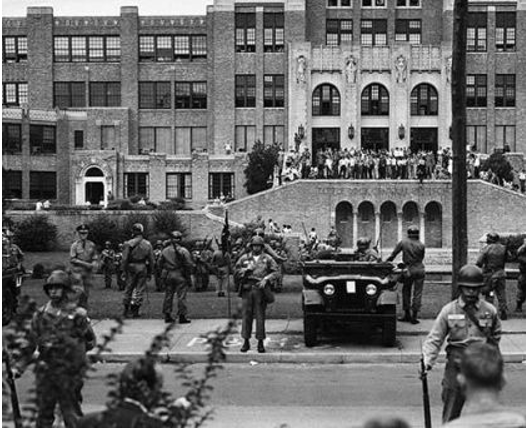By Blackpast.org

Listed below are the African American National Historic Landmarks by states in the South and Southeast, as certified by the National Park Service’s National Register of Historic Places. – See more at blackpast.org.
ARKANSAS
Camden:
Camden Expedition Site
This is the site of a host of different Civil War Battle sites. The Poison Spring Battlefield site has significance for African American history, as it is a site where black Union troops suffered heavy casualties. Also, Jenkins Ferry Battlefield is where the Kansas Colored Regiments of the Civil War fought a battle against the Confederacy.
Fort Smith:
Bass Reeves Statue
This statue is dedicated to Bass Reeves who served as U.S. Deputy Marshal in the Indian Territory from 1875 to 1907 when Indian Territory and Oklahoma Territories were combined to become the State of Oklahoma.
Little Rock:
Daisy Bates House
Mrs. Daisy Lee Gaston Bates resided at this address during the Central High School desegregation crisis in 1957-1958. The house served as a haven for the nine African American students who desegregated the school and a place to plan the best way to achieve their goals.
Little Rock Central High School
This is where the first major confrontation over the implementation of the Brown v. Board of Education 1954 Supreme Court ruling occurred, in 1957.
FLORIDA
Daytona Beach:
Howard Thurman House
Author, philosopher, theologian, and educator Howard Thurman spent most of his childhood in this late 19th-century house. His work influenced Martin Luther King, Jr. and provided the philosophical foundation for a nonviolent civil rights movement.
The Mary McLeod Bethune Home
This was the residence of the educator and civil rights leader on the campus of Bethune Cookman College from the early 1920s until her death in 1955.
Florida Keys:
USS Alligator
Built in the Boston Navy yard in 1820, this warship saw duty in 1821 and 1822, patrolling the west coast of Africa on anti-slavery trade duty. The wreck of the U.S. Schooner Alligator can be found near the Alligator Reef Lighthouse on the Atlantic Ocean side of the Florida Keys, Florida.
Franklin County:
British Fort Gadsden
This fort was once a place where runaway slaves lived alongside Seminole Indians. It was built in 1814 as a base for recruiting blacks and Indians during the War of 1812. The British abandoned it to their allies in 1815, after which it became a beacon for rebellious slaves.
Jacksonville:
American Beach Historic District
American Beach near Jacksonville, Florida, was founded in 1935 by the Afro-American Life Insurance Company of Jacksonville as an oceanfront resort for African Americans. It was added to the National Register of Historic Places in 2002.
Bethel Baptist Institutional Church
Bethel Baptist Institutional Church is the oldest black Baptist Church in Florida. It was added to the National Register of Historic Places in 1978.
Kingsley Plantation
This is the oldest known plantation in Florida, established in 1763. The plantation has been restored as a house museum. It displays exhibits and furnishings that depict plantation life during the period of 1763-1783.
Palm Beach:
Hurricane of 1928 African American Mass Grave
This is the burial site of approximately 674 victims, primarily African American agricultural workers, who were killed in the hurricane of 1928 that devastated South Florida. It was one of the worst natural disasters in American history.
St. Augustine:
Fort Mose
Fort Mose is the site of the first free African settlement in what is now the United States. Founded in 1738 by Spanish colonists offering asylum to slaves from the British Colonies, it is also one of the original sites on the southern route of the Underground Railroad.
Lincolnville Historic District
This historically black neighborhood was originally founded in 1866 by former slaves. Jim Crow laws from 1890 and 1910 spurred the growth of Lincolnville’s black owned and operated commercial enterprises, and in 1964 its politicized community institutions became the sites and bases from which many Civil Rights Movement marches began.
GEORGIA
Atlanta:
Atlanta University Center Historic District
Created in 1929, this consortium of historically black colleges includes the Clark Atlanta University, Spelman College, Morehouse College and the Morehouse School of Medicine. Students are able to cross-register at the other institutions in order to attain a broader collegiate experience. Several of these institutions played an important role in the Civil Rights Movement of the 1950s and 1960s.
Martin Luther King Historic District
This National Historic Site located within several blocks of Atlanta’s Auburn Avenue features Dr. Martin Luther King Jr.’s birthplace home, gravesite, and the church where King served as assistant pastor.
Sweet Auburn Historic District
This historic African American neighborhood is where African American businesses moved after the Atlanta Race Riot of 1906.
Albany:
Mount Zion Baptist Church
Constructed in 1906, this brick church served as the religious, educational, and social center of Albany’s African American community, especially during the Civil Rights Movement.
Augusta:
Paine College Historic District
Representing one of the few institutions of higher education created by a biracial board of trustees in Georgia for African American students in 1882, Paine College Historic District is important for its role in education and African American heritage.
Midway:
Dorchester Academy Boys’ Dormitory
Dorchester Academy was founded by the American Missionary Association (AMA) following the Civil War as a primary school for black children in the 1890s. It is nationally important as the primary site of the Citizenship Education Program sponsored by the Southern Christian Leadership Conference (SCLC) between 1961 and 1970.
Sapelo Island:
Behavior Cemetery
This cemetery is a unique post civil-war African American burial ground that reflects African American burial customs. The oldest tombstone death date is 1890, although tradition holds that burials have taken place at this location since antebellum times.
Vienna:
Vienna High and Industrial School
Built in 1959, Vienna High and Industrial school is an excellent example of an equalization (an educational facility created to be equal among African-American and white students) school in Georgia and is significant in the areas of architecture, education, ethnic heritage and social history.
KENTUCKY
Berea:
Lincoln Hall, Berea College
Founded in 1887 to both black and white students, this hall on the Berea College Campus served as the focus of civil rights activity for nearly a century.
Nicholasville:
Camp Nelson
Camp Nelson was a large Union quartermaster and commissary depot, recruitment and training center, and hospital facility established during the Civil War in June 1863. After March 1864, Camp Nelson became Kentucky’s largest recruitment and training center for black troops.
Simpsonville:
Whitney M. Young, Jr. Birthplace
Educator and civil rights Leader Whitney M. Young lived at this home until he was 15. He spent most of his career working to end employment discrimination in the South and turning the National Urban League into a strong grass roots organization for racial justice.
LOUISIANA
Alexandria:
Arna Wendell Bontemps House
This house is the birthplace of writer Arna Bontemps, a major figure in the African American literary movement known as the Harlem Renaissance.
Dorseyville:
St. John Baptist Church
Built between 1871 and 1875, the church is significant because it represents the earliest period of the African-American community in Dorseyville, which formed this town, located in sugar cane plantation fields, just after the Civil War.
Jackson:
Port Hudson
This was the site of a 48-day long Civil War siege, when 7,500 Confederates resisted some 40,000 Union soldiers for almost two months in 1863. Union casualties included 600 African-Americans of the First and Third Louisiana Native Guards.
New Orleans:
James H. Dillard Home
This is the former residence of Dillard, who spent most of his life improving the education of blacks in the U.S.
Eagle Saloon, Karnofsky Tailor Shop and House, and Iroquois Theater
In the first half of the 20th century, South Rampart Street was once a flourishing entertainment and commercial district for African Americans containing drugstores, barber shops, theaters, live music venues, combination grocery stores/saloons, second-hand stores, saloons and pawn shops.
Oscar:
Cherie Quarters Cabins
These twin cabins are all that remain of the slave quarters on the historic Riverlake Plantation. They are a rare surviving example of a once common building type in the antebellum south.
Springfield:
Carter Plantation
In 1817, Thomas Freeman became the first African-American man to own property in Livingston Parish when he acquired the pine forest in this area that he would transform into what has come to be known as the Carter Plantation.
Xavier:
Xavier University Main Building, Convent, and Library
Founded in 1915, this University provided a quality education to thousands of African Americans, principally from New Orleans and elsewhere in Louisiana, despite the widespread inequities during the Jim Crow era.
Wallace:
Evergreen Plantation
This Plantation home is a prime example of the major slave plantations found in the Antebellum period. It is composed of 39 buildings, including a main house and slave quarters. Parts of the movie Django Unchained were filmed at this plantation.
TENNESSEE
Fort Pillow:
Fort Pillow State Park
This well-preserved historic fort and 1,642 acre state park is where black troops were massacred by Confederate troops led by Lieutenant General Nathan Bedford Forrest in the Battle of Fort Pillow.
Memphis:
Beale Street Historic District
This street is the birthplace of the Blues style of music.
Mason Temple, Church of God in Christ
Built between 1940 and 1945, Mason Temple served as a focal point of civil rights activities in Memphis during the 1950s and 1960s. It was here that Martin Luther King, Jr., delivered his prophetic “Mountaintop” speech on the eve of his assassination.
Nashville:
Fisk University, Jubilee Hall
This L-shaped six-story Victorian Gothic dormitory is the oldest and largest building at Fisk University and the oldest permanent building for the higher education of Negroes in the United States.
Pearl High School
Pearl High School grew out of an elementary school founded in 1883. It was one of the first high schools for African Americans in Tennessee. It became an educational center for the fine arts and music, and the school developed a nationally known football and basketball program.
See more at blackpast.org.




